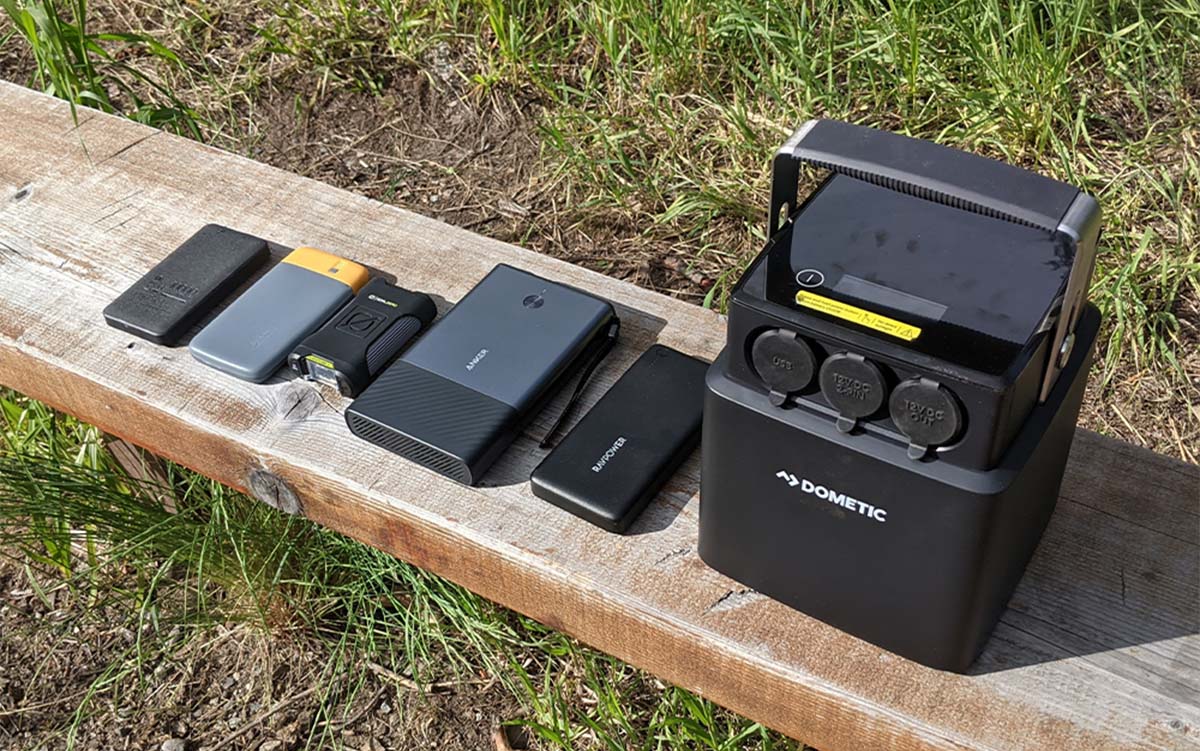We may earn revenue from the products available on this page and participate in affiliate programs. Learn More ›
It only takes one dead phone battery to make you realize the importance of a power bank for camping. Whether it’s snapping a picture of the local flora and fauna, setting an alarm for your sunrise hike, or accessing directions for the drive home, it’s essential that you have enough juice to last to the end of your trip. To help make sure you never lose power in the outdoors again, I tested some of the best power banks for camping on the market today:
Best for Small Electronics (Phones and Laptops)
Best for Large Electronics (Overlanding and Electric Coolers)
The Best Power Banks for Camping: Small Electronics, Phones, and Laptops
Best Overall: Scosche PowerUp 32K
Photo by Laura Lancaster
Buy from Amazon
Pros
- Easy-to-read display shows how much power is left
- AC outlet
- Impressive flashlight
- Easy-to-use handle
Cons
- Was only able to power one device at a time during testing
Key Features
-
Warranty:
1 year -
Up to 100W output -
Included Cables:
One USB-C to C (also includes a 20W USB-C wall charger) -
Built-in flashlight
Specs
-
Weight:
2.2 pounds -
Internal Battery:
32,000 mAh -
Ports:
Two USB-A, one USB-C, and one AC outlet
The features on the PowerUp 32K were the most impressive of any power bank in my test. First off, it had an AC outlet, which was powered by a simple on/off button that was separate from the USB on/off switch. You wouldn’t think that you’d need an AC outlet while out camping, but when it does come up it’s so handy to not have to worry about it. It also has a digital display, providing an even more accurate and intuitive read of how much power was left.
But where this power bank really stood out was its flashlight. While other products in my test looked like power banks for camping that someone had added a flashlight on to, the PowerUp 32K is more like one of the best flashlights that someone built a battery pack into — it was the brightest in my test, with a side handle that made it easy to carry while looking for my tent after dusk.
Best for Phones: Inui Power Bank BI-B6
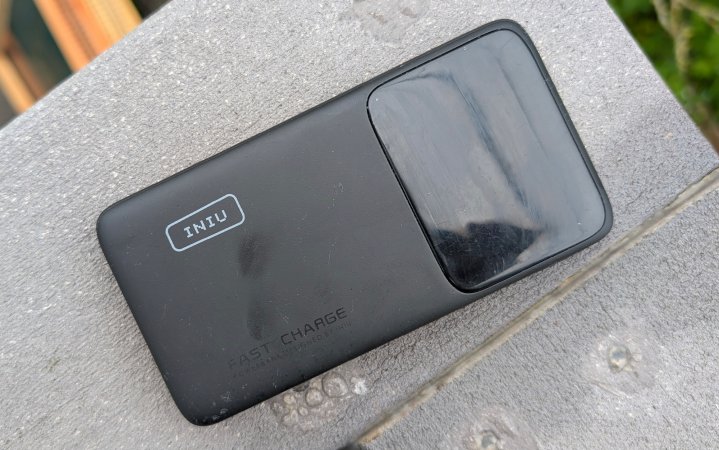
Photo by Laura Lancaster
Buy from Amazon
Pros
- Easy to see how much power is left
- Holds enough power for several phone recharges
- Built-in flashlight
- Inexpensive
Cons
- Can take a few tries to charge out of the box
Key Featurs
-
Weight:
7.5 ounces -
Average Watt Hours Held During Testing:
26 watt hours -
Two USB-A ports and one USB-C port
While I wasn’t originally all that impressed with this Inui phone charger, I’ve come back to it again and again for one simple reason: just like I like to know exactly how much juice is left in my phone, it’s really nice to know exactly how much juice is left in my power bank. Rather than just a few blinking blue light, this one has a display that shows what’s left in your power bank, making it easy to determine how much charge you can expect out of it for your phone.
Like other, newer power banks, this one charges via USB-C cable, but has two USB-A ports, so you can still use your lightning or micro USB cables for the time being. The affordable price point also makes it a great option for a small gift or last-minute purchase to round out your camping kit.
The only issue with this charger is that, out of the box, it can take a few tries to get it to charge initially. But after using this power bank for over a year, this issue has reduced significantly.
Best for Remote Work: Anker SOLIX C300
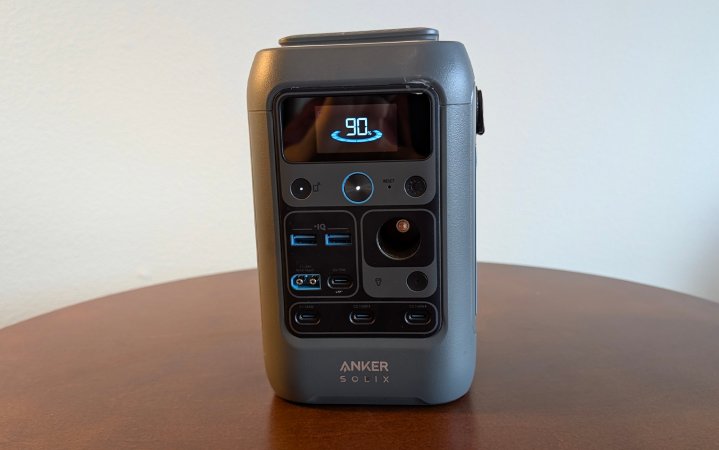
Photo by Laura Lancaster
Buy from Amazon
Pros
- Small
- Easy to transport
- Holds a surprising amount of power
- Great features like car charger and lantern
Cons
- Easy to plug in a larger solar panel than the unit can handle
- Version with AC plug is significantly more expensive
Key Features
-
Capacity:
288 watt hours -
140 watt two-way fast charging port -
Can be paired with a 100 watt solar panel
I’ve been using the Anker SOLIX C300 for several months now, and have been impressed both by how easy it is to use and by how portable it is. While not as weather protected as other options (like my best large pick, the Goal Zero Yeti 700), the Anker SOLIX C300 does have several features that make it a great option for camping. The first is a car charger, which can be used for electronics like the best electric coolers or pumps for the best inflatable paddle boards. It also has a port for charging from solar (see my take for the best solar panels for camping), and a lantern that is on par with the best camping lanterns.
And it manages all this while still being surprisingly petite. It won’t fit in your glovebox like the Anker Powerhouse 90, but you’ll definitely find a spot to fit it in with the rest of your camping setup. Only note of caution is to be careful when plugging in a solar panel, as anything more than 100 watts will fry the internal electronics — something I found out the hard way.
Best for Fast Charging: Anker 737 Power Bank

Buy from Amazon
Buy from Anker
Pros
- Fast charging
- Easy to see how much power you’re using, and what’s left
Cons
- No AC port
- Display can drain the battery quickly if left on
Key Features
-
Ports:
One USB-A and two USB-C -
Included Cables:
One USB-C to C -
Warranty:
2 years
Specs
-
Weight:
1.4 pounds -
Internal Battery:
24,000 mAh -
Up to 140W output
The more than impressive power output of the Anker 737 Power Bank combined with its best-in-class display screen made for an unusually impressive user experience. Unlike other power banks I’ve looked at, where I’m guessing at the actual power usage based on how fast the blinking lights are disappearing, this provides detailed information on each port, down to the tenth of a watt. It even provides lifetime information on the health of the battery, including the total watt hours you’ve inputted and outputted (although, strangely, it doesn’t tell you the number of watt hours left in the battery itself). The power output here is fast, too: you’ll be more limited by your available cables than you will be by your power bank (fortunately Anker provides a USB-C cable capable of delivering up to 140W of power). You may also be limited by your devices. Even plugging two laptops and a smartphone into this setup, I wasn’t coming anywhere near the 140W limit.
While I did not have a single device to test the 140W capabilities of the Anker 737, plugging in multiple devices that should have added up to 140W proved unsuccessful: the device wouldn’t go over 100W. No matter, that will still be plenty of power for most people’s devices and that setup will still take down a fully charged Anker 737 in less than an hour.
My only gripes with the Anker 737 are with the display. While it’s easy to read indoors, outside, even in dim light, it can be difficult to read the screen. Also, if you leave the screen on for too long (it can be set to not turn off), it will drain your battery surprisingly fast. And while I do wish the Anker 737 had an AC port, I suspect that the need for these is likely to decrease rapidly in the coming years. Possibly even enough to elevate this power bank for camping to the top slot.
Best for Bad Weather: NestOut Power Bank

Photo by Laura Lancaster
Buy from Amazon
Pros
- Great weather resistance
- Nice design
Cons
- Fewer ports than other options I’ve tested
- Heavy
Key Features
-
Weight:
8.5 ounces -
Ingress Protection:
IP67
Specs
-
Capacity:
10,000 mAh -
Max Output:
20 watts
If you’re prone to leaving your power bank out on the picnic table overnight, then you might want something that is a little more durable than some of the picks on this list. The NestOut power bank, which comes in a variety of sizes, is extremely durable, with an ingress protection (IP) rating of 67, the highest of anything I looked at. In addition to being virtually dustproof, you could drop this one off the side of your boat and still safely use it. A little rain is no problem. I also appreciated that the mechanism for protecting the ports when not in use was so straightforward, a simple screw cap that is connected to the power bank itself.
The downside here is that in addition to being pricier than other comparable power banks, it’s also fairly heavy. It wouldn’t be my first choice for a day hike, let alone a backpacking trip. But if you regularly setup a basecamp in some wild and wet conditions, then consider this one a must.
Best Small: BioLite Charge 20 PD
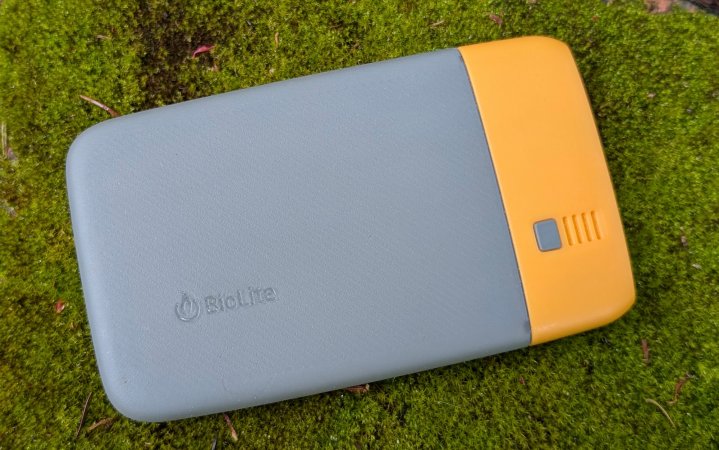
Photo by Laura Lancaster
Buy from REI
Buy from BioLite
Pros
- Inexpensive
- Small size means it can also be used for backpacking
Cons
- Not as powerful as other options
Key Features
-
Warranty:
One year -
Up to 18W output -
Included Cables:
One USB-A to C
Specs
-
Weight:
5.8 ounces -
Capacity:
22.2 watt hours -
Ports:
Two USB-A and one USB-C
The vast majority of car campers are using their power bank for just one thing: keeping that phone charged. And even though (at least we hope) you’re off the grid, free from the YouTube autoplay and Facebook algorithm, you’ll probably still need to use your phone for at least a couple of things. Photos. Alarm clock. Offline maps. Getting down to less than 10 percent on a camping trip can be a little stressful.
The BioLite Charge 20 PD is exactly what you need at the right price. It’ll recharge your and your camping partner’s phone (simultaneously, if necessary), it doesn’t take up a lot of space, and it’ll leave you with plenty of spare funds for the rest of your camping outfit. It’s also easy to use, with clearly labeled ports and an easy-to-read charge bar made up of four lights that blink when charging and hold steady when full.
Best Extra Small: Goal Zero Flip 12
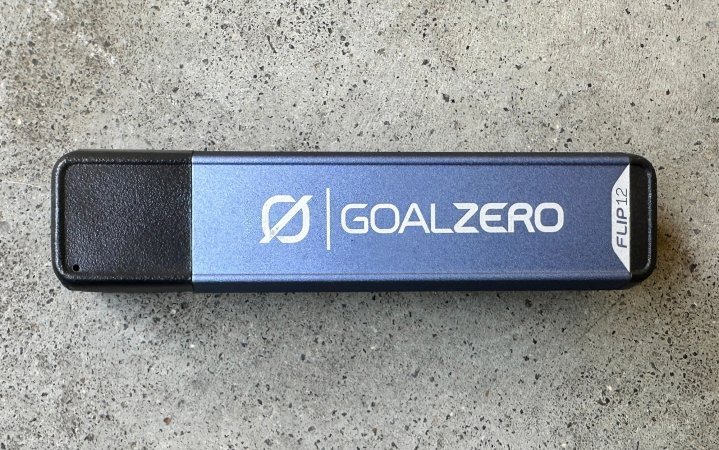
Photo by Scott Einsma
Buy from Cabela’s
Pros
- Fits in your pocket
- Affordable
- Built in recharging cable
Cons
- Not as powerful as larger options
- Tendency to come unplugged
Key Features
-
Built-in USB-A recharger -
Battery Chemistry:
NMC
Specs
-
Capacity:
12 watt hours -
Weight:
2.5 ounces -
Max Output:
5 watts
Gear editor Scott Einsmann has been using the Goal Zero Flip 12 for a few years now, and is impressed with its performance. It reliably recharges his phone (and then some), and more importantly, it doesn’t take any space in his kit. This is one of the few power banks we’ve tested that you can recharge without a separate cable, as the USB-A plug is built in. He reports that, due it’s small and streamlined design, it can come unplugged if you aren’t careful with it.
Best Budget: Miady AS-TPB21

Photo by Laura Lancaster
Buy from Amazon
Pros
- Very affordable
- Two for one
Cons
- Case showed signs of wear after the drop test
Key Features
-
Weight:
7.9 ounces -
Average Watt Hours Held During Testing:
25 -
Two USB-A ports, one micro USB port, and one USB-C port
The lightweight Miady AS-TPB21 was not only the least expensive option I tested, it was even a two-for-one deal, making it a total steal. That’s the kind of budget option that typically proves lacking during testing. But not so with the Miady. It performed just as well, if not better, than other lightweight power banks I’ve tested at. If I had to ding the Miady AS-TPB21 on something, it’s that it is less durable. Expect some scuffing on this unit if you drop on a hard surface. Treat this one a little more gingerly, but at least you’ll have a second one on hand if it does break.
Goal Zero Venture 35
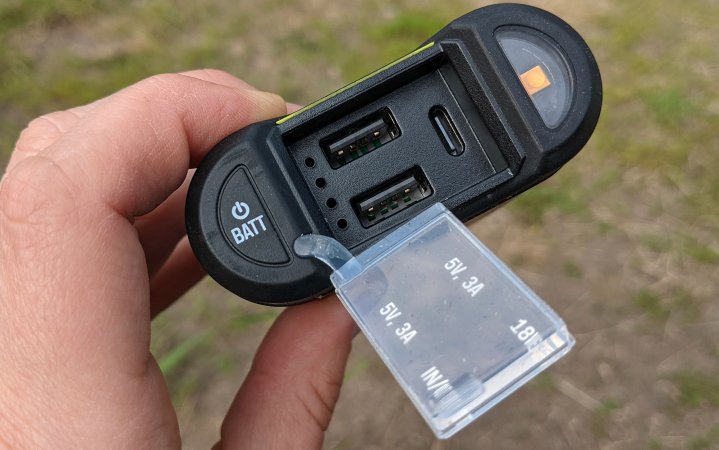
Photo by Laura Lancaster
Buy from Cabela’s
Buy from Amazon
Pros
- Very water resistant
- Small size is portable
- Fastest charge time in my test
- Includes a flashlight
Cons
- Slightly higher price than other power banks in the 10,000mAh range
- Performed third in my test of power banks in the 10,000mAh range
Key Features
-
Warranty:
1 year -
Up to 18W output -
Included Cables:
One USB-A to C -
Also available as the 19,200mAh Venture 75 power bank -
Built-in flashlight
Specs
-
Weight:
10.12 ounces -
Internal Battery:
9,600 mAh -
Ports:
Two USB-A and one USB-C
Most car campers will store their power bank in their car, or maybe their tent. But if you anticipate bringing yours along for a hike or having it next to you while cooking up dinner, then the Goal Zero Venture 35 might be the better choice for you. In addition to its rubber housing, it also has a silicone plug that seals in the three ports and the four lights indicating how much charge is left in the power bank. I also liked that holding down the power button activated a flashlight, which is always handy when you’re making the trek to your tent after extinguishing that evening’s campfire. While this one didn’t have as much juice in it as the BioLite Charge 40 PD or Mophie Powerstation (even when taking into account its smaller internal battery), if you think there is a chance that your power banks for camping could be exposed to the elements, then this is the better pick for you. (Those concerned about battery size also have the option to level up to the 19,200mAh Venture 75).
Despite the more robust bonafides of this power bank for camping, don’t be fooled into thinking it’s bombproof. The silicone plug is secured to the rest of the power bank by a relatively thin strip that, when pulled during testing, snapped and broke off fairly easily. While the casing still works even when no longer tethered to the power bank, its waterproof capabilities would be severely diminished if it was lost or left unsecured.
The Best Power Banks for Camping: Overlanding or Electric Coolers
Best Overall: Goal Zero Yeti 700
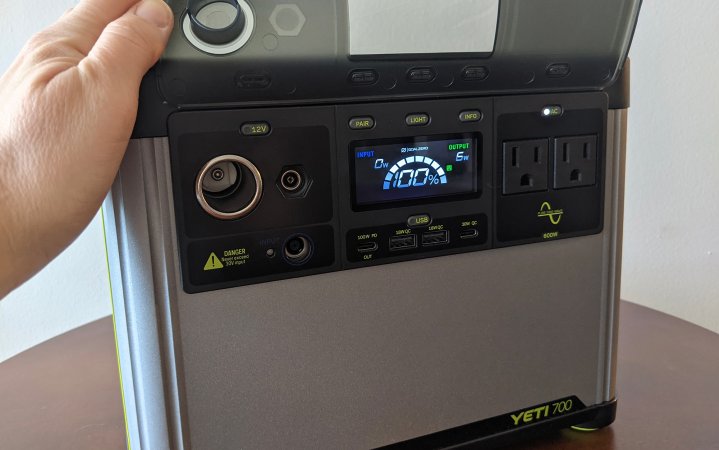
Photo by Laura Lancaster
Buy from Amazon
Buy from REI
Pros
- Great water and dust protection
- Very effecient
- Accurate control panel readings
- Displays the power loss through the AC ports
Cons
- Power button is in an unintuitive location
- Not available in a larger size (Goal Zero does make other sizes of other power station models)
Key Features
-
Other Available Sizes
297 watt hours, 499 watt hours -
Warranty:
5 years
Specs
-
Weight:
20.9 pounds -
Battery Chemistry:
LiFePo4 -
Manufacturer Claimed Lifecycles to 80 Percent Capacity:
4,000
The Goal Zero Yeti 700 was one of the most impressive units in my test of the best portable power stations and would be an excellent choice for just about any camping setup. It achieved 70 percent efficiency against its stated 677Wh size and powered a 34W grow light for over 13 hours. Unlike other units, the Goal Zero Yeti 700 also shows the power being used by the power station. To me, this is the right way to handle this: Users are more likely to wonder how much energy the power station is using to power a particular appliance than wonder how much energy the appliance itself is using. It also serves as a reminder to turn the AC outlets off when they aren’t in use, as they represent a fairly significant drain on the battery.
The fold down handle of the Yeti 700 makes it easy to carry from car to picnic table. And I liked that a silicone flap covers the ports when not in use, protecting them from dust and other debris.
My only gripe with this otherwise excellent unit is that it is a little less intuitive to use than the others. For instance, the power button is on the back of the unit, by the charging input port, rather than on the front.
Best Value: Oupes Mega 1
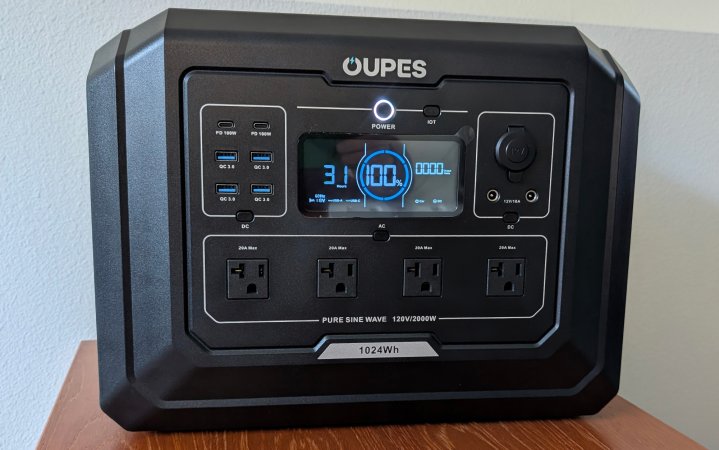
Photo by Laura Lancaster
Buy from Oupes
Pros
- Holds a charge well over time
- Great value for power output
Key Features
-
Warranty:
3 years -
Battery Chemistry:
LiFePO4 -
Weight:
27.8 pounds
Specs
-
Capacity:
1024 watt hours -
IP Rating:
IP21 -
Max Output:
2000W (AC), 100W (USB-C)
There are plenty of so-called budget power stations out there, but the one that impressed me most in my test of the best portable power stations was the Oupes Mega 1. It had the same, best-in-class battery chemistry as similar models from the likes of Goal Zero, Anker, and Jackery. It had a reasonably battery capacity to packed size. And it recharges quickly. In testing, it wasn’t as efficient as others units, but it was close enough that the vast majority of campers are unlikely to notice.
Unlike my best overall pick, however, you’re going to want to take extra care with this one. With an ingress protection rating of only IP21, it’s very susceptible to damage from both dust and water. Keep this one in your car or tent as much as possible.
Best Extra Large: Anker SOLIX F2000
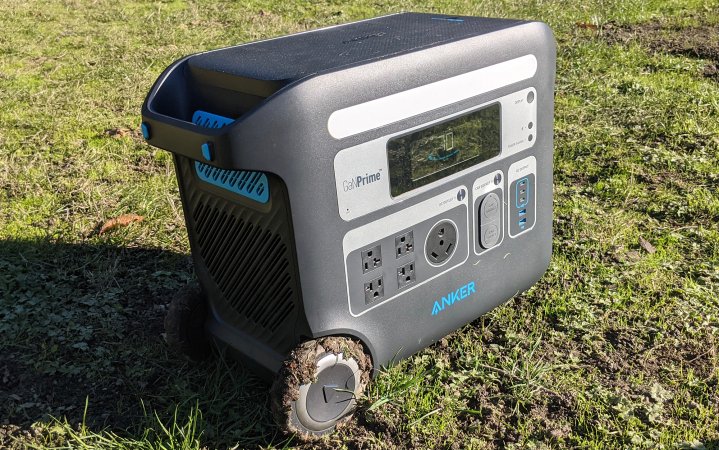
Photo by Laura Lancaster
Buy from Amazon
Pros
- Easy to move around rough terrain
- You can plug you RV in
Cons
- Heavy
- Loses a noticeable amount of power in storage
Key Features
-
Power Station Capacity:
2048 watt-hours -
Solar Panels:
Two 200-watt solar panels
Specs
-
Max AC Output:
120 volts and 2400 watts -
158 watts generated by one panel in direct sunlight
The larger power stations all come with wheels and telescoping handles to help you move it around your house (although don’t ask me how. you are meant to handle stairs), but one of the better wheel/handle combos is definitely this Anker SOLIX F2000. I pulled this power station around my living room. I pulled it around a parking lot. I pulled it around a muddy field. It handled equally well in all conditions, something that could not be said for the other wheeled power stations.
This power station is also notable for having a larger capacity, and more varieties of ports, than others that I looked at. If you know you need a lot of power, but aren’t sure what form that will take or where you’ll need it, this is an obvious choice. It will also serve you well if you are starting to build out an overlanding kit and need a versatile unit that can play well with a variety of devices.
While I was impressed with the app for this power station during my initial testing, over time I’ve moved away from testing these. Ultimately, they eat up too much power from both your phone and the actual power station. Finally, be sure to check the power on this one during the off-season, it has a tendency to leak power faster than other power stations I’ve tested. If the battery stays to low for too long, it can end up damaging it.
Best for Solar Generators: Bluetti AC60
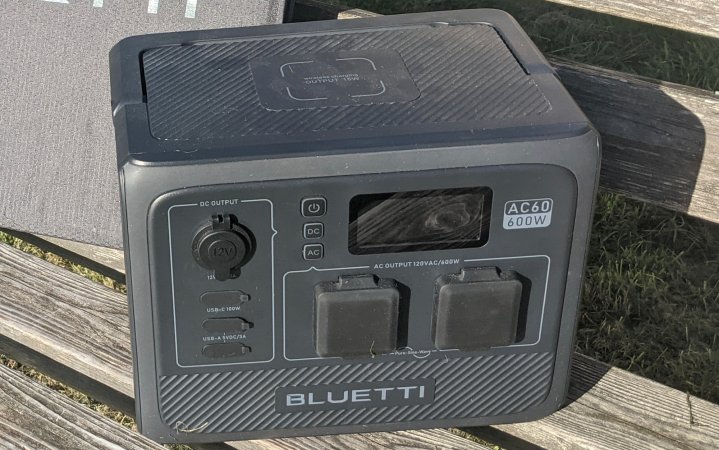
Photo by Laura Lancaster
Buy from Amazon
Buy from Bluetti
Buy from Walmart
Pros
- Dustproof and water resistant
- Has wireless charging
- Great warranty
Cons
- Not as efficient as others I’ve tested
Key Features
-
Warranty:
6 years -
Ports:
Two AC, USB-C, two USB-A, one car charger -
Included Cables:
AC charging cable, car charging cable, solar panel charging cable -
* Also available with a 800Wh expansion pack
Specs
-
Internal Battery:
403 watt hours -
Weight:
20 pounds -
Max AC Output:
120 volts and 600 watts
There are a lot of advantages to having a solar generator setup while camping. Assuming the right conditions — clear skies and no obstructions — you can get by with a much smaller (and cheaper) power station by recharging with the power of the sun.
While Goal Zero makes excellent power stations, I’ve been less impressed with their solar panels. But one of my favorite solar panels, a 100-watt powerhouse, comes from Bluetti. It pairs best with this power station with separate protective covers over its ports. That means that you can keep everything protected from both rain and dust while you’re charging up, only exposing the ports when you need to plug something in. The rating on this is IP (ingress protection) 65, which means it’s fully dustproof and can handle a very serious rainstorm. (Don’t go dropping it in the lake, though.)
Best for Electric Coolers: Bluetti Pioner MD
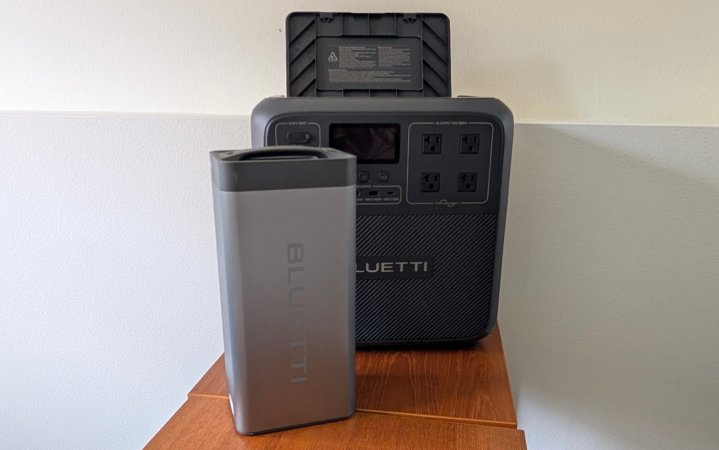
Photo by Laura Lancaster
Buy from Bluetti
Buy from Amazon
Pros
- Can be paired with Bluetti’s excellent solar panels
- Internal batteries can be paired with Bluetti’s electric cooler
- Good warranty
Cons
- Expensive
- Heavy
- Not suitable for difficult weather
Key Featuers
-
Warranty:
5 years -
Battery Chemistry:
LiFePO4 -
Weight:
58.4 pounds
Specs
-
Capacity:
1434 watt hours -
IP Rating:
None -
Max Output:
1800W (AC), 100W (USB-C)
If you’re looking to upgrade your typical car camping kit to something better suited for overlanding, then you’re probably considering one of the best electric coolers. One of the better options for creating an integrated ecosystem is the Bluetti MultiCooler paired with the Bluetti Pioneer MD power station. Unlike other power stations, you can remove the battery from the power station and plug it directly into the cooler. That means you can have your power station charging up the second battery in full sunshine (check out my take on the best portable solar panels) while your cooler stays cool in the shade.
What stood out in testing about the Bluetti Pioneer MD is that this power station is quite heavy. Most people will find it a bit of a chore to move around from place to place. If you need something portable, this isn’t it. It also doesn’t have the IP (ingress protection) rating of other picks on this list, so you’ll need to make sure it’s moved back into the car when. the dust or rain starts to kick up. That being said, it has an excellent warranty, and the modular design is a unique one that allows for a more versatile setup.
How I Tested the Best Power Banks for Camping
I’ve been testing the best power banks for camping in several ways over multiple years. I’ve taken them on car camping trips, exposing them to sun and wind, with temperatures dropping down into the forties at night. I’ve used the chargers for numerous purposes, including charging my phone, charging my laptop, and charging/powering the pumps for the best camping mattresses for couples. During testing, I paid attention to which chargers I packed in my car and reached for the most often, and how long they lasted me for.
I used this experience to inform several larger tests over the last several years, including my test of the best portable power stations and my test of the best power banks for backpacking. The results of these tests have informed several of my selections.
Things to Consider Before Buying Power Banks for Camping
Battery Size of the Best Power Banks for Camping
The battery size you’ll need for your camping trip depends on the number and type of devices you’ll need to charge, how long you plan to be out for, and whether you have a way to recharge your power bank (such as a solar panel or solar generator).
Outlet Options for the Best Power Banks for Camping
If you’re just looking to charge a phone, then a USB-A outlet along with a matching cable is all you’ll need to get going. Not all power banks feature AC outlets, so if you need one for an air pump or laptop, stick with the best overall or best features picks.
Voltage of the Best Power Banks for Camping
Before purchasing a power bank, first take a look at what you’re hoping to charge during your camping trip. If you’re just looking to power a phone, you’ll need significantly less voltage, and are likely to go through fewer milliamp hours (mAh), than if you are looking to power a laptop, CPAP machine, or electric cooler.
Portability of the Best Power Banks for Camping
The power banks I tested in this roundup were chosen for their portability, as most car campers have limited space in which to store electronics in their vehicles. Since most campers’ power needs are relatively limited compared to what they go through at home, I recommend starting with a smaller power bank at first (unless you need to power a medical device) and then sizing up as you get a better understanding of your needs.
FAQs
Power banks for camping can cost anywhere from $50 to upwards of $1,000, usually depending on the size of the internal battery and the wattage they can support. Another factor that can affect price is additional features, such as waterproofing, flashlights, and electronic displays.
A spec you’ll often see is mAh, which stands for milliamps hour. The mAh spec is a measurement of power over time — the higher the mAh the more power the battery contains. To fully charge a phone you’ll need 3,000 to 5,000 mAh. There is a big price jump between 10,000mAh and 20,000mAh power banks for camping, so if you’re not sure which one you want to buy, it’s good to consider what your needs are first. Typically, a 10,000mAh battery size will provide enough juice for a couple of phone charges. If you’re heading out for a weekend — and you aren’t planning to watch a movie on your iPad — this is likely sufficient. If you’re heading somewhere out of cellphone range, one way to increase your battery life is to check that your phone is switched to airplane mode.
A power bank is a great way to charge your electronics while camping, so long as you ensure that you have the right power cords and that the voltage and size of your battery pack is sufficient for the needs of your electronics. This is especially important if you are planning to use a battery pack to power a CPAP machine at night. Many campers pair power banks with solar panels when they plan to power electronics in the outdoors for more than a long weekend.
Final Thoughts on the Best Power Banks for Camping
After testing out a number of the best power banks in a range of sizes, I’m confident that most people will get the power needs they are looking for with the Scosche PowerUp 32K. Campers looking to power heavier duty electronics, however, should size up to the Goal Zero Yeti 700 or Anker SOLIX F2000.
Read the full article here



